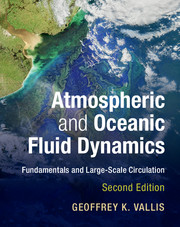Book contents
- Frontmatter
- Dedication
- Contents
- Preface
- Notation
- PART I FUNDAMENTALS OF GEOPHYSICAL FLUID DYNAMICS
- PART II WAVES, INSTABILITIES AND TURBULENCE
- PART III LARGE-SCALE ATMOSPHERIC CIRCULATION
- PART IV LARGE-SCALE OCEANIC CIRCULATION
- 19 Wind-Driven Gyres
- 20 Structure of the Upper Ocean
- 21 The Meridional Overturning Circulation and the acc
- 22 Equatorial Circulation and El Niño
- References
- Index
21 - The Meridional Overturning Circulation and the acc
from PART IV - LARGE-SCALE OCEANIC CIRCULATION
Published online by Cambridge University Press: 09 June 2017
- Frontmatter
- Dedication
- Contents
- Preface
- Notation
- PART I FUNDAMENTALS OF GEOPHYSICAL FLUID DYNAMICS
- PART II WAVES, INSTABILITIES AND TURBULENCE
- PART III LARGE-SCALE ATMOSPHERIC CIRCULATION
- PART IV LARGE-SCALE OCEANIC CIRCULATION
- 19 Wind-Driven Gyres
- 20 Structure of the Upper Ocean
- 21 The Meridional Overturning Circulation and the acc
- 22 Equatorial Circulation and El Niño
- References
- Index
Summary
THE MERIDIONAL OVERTURNING CIRCULATION, or the moc, of the ocean is the circulation associated with sinking mostly at high latitudes and upwelling elsewhere, with much of the meridional transport taking place below the main thermocline. Understanding this circulation is one of the main goals of this chapter. The theory explaining the moc is not nearly as settled as that of the quasi-horizontal wind-driven circulation discussed in Chapter 19, but considerable progress has been made, in particular with a significant re-thinking of the fundamentals occurring in the late 20th and early 21st century, as we will discover. Our other main goal is to glean an understanding of the Antarctic Circumpolar Current, or acc, the theory of which has also undergone a transformation over that same period. The acc is important not only in its own right, but because it mediates the mocs of the individual ocean basins, connecting them into a global circulation.
That there is a deep circulation has been known for a long time, largely from observations of tracers such as temperature, salinity, and constituents such as dissolved oxygen and silica. We can also take advantage of numerical models that are able to assimilate observations (from hydrographic measurements, floats and satellites) and produce a state estimate of the overturning circulation that is consistent with both the observations and the equations of motion, and one such estimate is illustrated in Fig. 21.1. We see that the water does not all upwell in the subtropics as we tacitly assumed in the previous chapter. In fact, much of the mid-depth circulation more-or-less follows the isopycnals that span the two hemispheres (Fig. 21.2), sinking in the North Atlantic and upwelling in the Southern Ocean, with the transport in between being, at least in part, adiabatic.
The moc used to be known as the ‘thermohaline’ circulation, reflecting the belief that it was primarily driven by buoyancy forcing arising from gradients in temperature and salinity. Such a circulation requires that the diapycnal mixing must be sufficiently large, but many measurements have suggested this is not the case and that has led to a more recent view that the moc is at least partially, and perhaps primarily, mechanically driven, mostly by winds, and so along isopycnals instead of across them.
- Type
- Chapter
- Information
- Atmospheric and Oceanic Fluid DynamicsFundamentals and Large-Scale Circulation, pp. 801 - 860Publisher: Cambridge University PressPrint publication year: 2017



